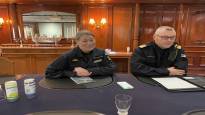STOCKHOLM/MUSKÖ Finland’s new naval commander Tuomas Tiilikainen visited Sweden’s Muskö naval base today, Wednesday. A trip to the south of Stockholm with the commander of the Swedish Navy Ewa Skoog Haslumia to meet was Tiilikainen’s first trip abroad as a commander. Tiilikainen took office at the beginning of the year.
The Muskö naval base is an illustrative example of the different phases of the Swedish Defense Forces. The three-story rock cave was put into use at the end of the 1960s and has been made to withstand the demands of a nuclear war. On the walls of the corridors there are still signs leading to the hospital, for example.
At the beginning of the millennium, Sweden estimated that nothing threatened it militarily and the Muskö base was emptied. In 2019, the commander of the navy moved back to the base, which means everything that the Swedish navy does is now managed from Muskö, i.e. Sweden’s five top-equipped submarines.
The submarines are manufactured by Saab and the company has premises in Muskö.
The base is only visible from the outside as far as the entrances. All photography is prohibited.
Today, the flags of Sweden, Finland and NATO flew outside the base.
Close cooperation between Sweden and Finland at sea
Tiilikainen and the Commander of the Swedish Navy, Ewa Skoog Haslum, receive in a room decorated with the noble wood of an old ship. The atmosphere is peaceful, even though there are dozens of meters of rock overhead.
In September 2022, two Nord Stream gas pipelines were blown up in the Baltic Sea, near Bornholm, in a way that was clearly aimed at harming civil society.
More than a year after the gas pipeline was damaged, the gas pipeline running between Estonia and Finland and the communication cable broke.
After the damage, the defense alliance NATO decided to increase patrolling in the Baltic Sea.
– It started almost immediately after those events were noticed. Very quickly, NATO also assigned ships to the regions to increase its presence here in the region. But at the moment, we have returned to a good basic readiness, with which we are able to monitor areas and proactively allocate units and surveillance capability to where more of it is needed.
– In other words, there is no such continuous enhancement of readiness, Tiilikainen clarifies.
According to Skoog Haslum, it is clear that the breach of the Nord Stream gas pipeline was a matter of sabotage, i.e. intentional damage, even though the investigation has now officially ended, and the perpetrators are at least not yet known.
According to the Swedish commander, it is absolutely right that the supervision has now returned to normal.
– I think that is the beauty of our defense forces and naval capabilities. We can be very flexible. We increase readiness very quickly, i.e. in hours, because we have our staff and equipment available. And then we have to be able to go back as well and not just raise the readiness all the time.
– So the nice thing is that we are vigilant and if something happens, we raise our readiness, Skoog Haslum underlines.
The threat to Finland has not increased
According to Tiilikainen, despite the pipe and cable damage, the military threat to Finland has not increased.
– Despite everything, the situation in the Baltic Sea is stable. There is currently no military threat to Finland. In that respect, we can be quite safe here.
– But, of course, there is more military activity in the Baltic Sea, and there can certainly be opportunities for the conflict to expand even by accident. But I don’t think that there is a direct risk to Finland, Tiilikainen estimates.
The Swedish commander’s assessment is the same, but he has cause for vigilance.
– We are not particularly worried about the Baltic Sea, but I am worried about the development of the whole world. I am very concerned about that, and I am by no means alone.
– Both we and Finland are on our toes. We are ready. We are much more vigilant today than, say, ten years ago.
– But that vigilance has not turned into worry. I am worried about how the world is developing, Skoog Haslum reasons.
The commanders of the Swedish and Finnish navies met on a day when Sweden’s NATO membership is closer than ever. The Swedish flag will be raised on the flagpole of the NATO headquarters possibly as early as next week.
According to the commanders, it does not change the cooperation between Finland and Sweden. It has been close for a long time, and not even a year’s worth of “separate association”, i.e. the fact that Finland has already been in NATO, has caused problems.
